Stone, minerals and semiprecious of the world stone
Phosphate: Pyromorfite (pyromorphite) -->rus
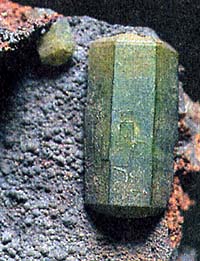 Diagnostic cart.
Diagnostic cart.
На фото: образец
из Пршибрама
в Богемии.
Pb5 (PO4)3 Cl
Crystal structure hexagonal
Hardness on the Mohs scale 3,5-4
Specific unit weight mass 6,7-7
Cleavage non-existent
Fracture, break padman
Colors colourless, multicolours
Colors in powder triturate white
Glance (glitter, glare) from diamond to resin
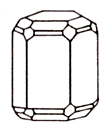
Pyromorfite (pyromorphite) is a chloride-phosphate of lead. Glance (glitter, glare) diamond to fat, transparent. Colors: green, bluish (cyan) -green, yellow, gold, brown, white: it is colourless (depending on colouring he is named green, brown or pied leaden ore). A line is white to yellow. Fracture, break padman, uneven. Fragile. Cleavage non-existent. Appears in the area of oxidization of sulfide multimetallic complex ore deposits. Crystals (hexagonal Crystal structure) columnar, basaltiform or thickplate tablet lamellar. Aggregates - botryoidal, kidney-shaped reniform, also crusts and raids. Often forms псевдоморфозы on a cerussite and galena, galenite. Important ore of lead.
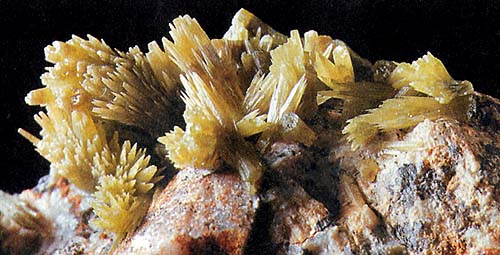 The crystals of pyromorphite are not too various in a due form, but widespread. Usually Pyromorfite (pyromorphite) is presented the individuals of clear prismatic type, either extended or short. Sometimes there is a round-off, with incoming inward verges, eaten shallow cavities. A green, yellow, brown, or grey secondary mineral that consists of lead chloro-phosphate in the form of hexagonal crystals.
The crystals of pyromorphite are not too various in a due form, but widespread. Usually Pyromorfite (pyromorphite) is presented the individuals of clear prismatic type, either extended or short. Sometimes there is a round-off, with incoming inward verges, eaten shallow cavities. A green, yellow, brown, or grey secondary mineral that consists of lead chloro-phosphate in the form of hexagonal crystals.
Completion of crystals is ordinary flat, but is and pointed. A mineral can form the groups ("druses") of subparallel shallow prismatic crystals or small massive accumulations of globular, ramified-radiant and kidney-shaped reniform structure also; there are disseminations and crusts.
Colors most various: except for green very different tints there are tones yellow, orange, brown, grey; quite a bit quite colourless or white varieties of pyromorphite. Powder always white. Glance (glitter, glare) varies from diamond to resin. Almost always long, prismatic crystals, often needle, are located parallell or radially; quite often growings, rarely with two heads; large standards are made from a few shallow; often have a barrel-shaped type ("smsky small casks"); spherical, cluster-like, grainy aggregates.
Chemical composition (chemistry, compound). Oxide of lead (PbO) 81,7%, five-oxide of phosphorus (P2O5) 15,7%, chlorine (Sl) 2,6%; admixtures of calcium, arsenic and chrome. Form of crystals. Prismatic, columnar, basaltiform, look like the crystals of apatite. Class of symmetry. Hexagonal-bipyramidal - 6/m. Cleavage. Absents practically. Aggregates kidney-shaped reniform, botryoidal, dense, continuous the masses, short-radial joint, junction.
Diagnostic indication.
We will dissolve in an aquafortis. In flame of candle melt fuse easily, forming a marble. Easily alloyed in a marble, yellow abandons on coal, gold raid. A behavior is in acids. Dissolves in Nno3. From mimetesite it is possible to distinguish only at a chemical analysis.
Origin provenance genesis.
Pyromorfite (pyromorphite) - second mineral, appearing in the area of oxidization of leaden deposits. There are also his псевдоморфозы on other minerals of lead, such as galena, galenite and cerussite. Second mineral beds of galena. Pyromorfite (pyromorphite) a long ago known as ore of lead. Most deposits are now mined-out.
Deposit minefield mine and use.
Being a widespread mineral, Pyromorfite (pyromorphite) is marked in many places in Italy. Among them Monte-falo and Alpe-Pirio in the commune of Zhinese near-by Stessa (province of Verbaniya), where the extended crystals of the intensive green colouring acted from. In Val-Brembane (in Bergamasko) there are crystalline disseminations, enough vast, with the greenish-yellowй colouring. Quite amazing standards find in the neglected mine of Chinkvevalli near Ronsen'o (Valsugana, province of Trento) and in the mineries of area of Kalyari.
Most famous European places which wonderful copies acted from: Yuse (France, EU); Bad-ems near-by Koblenca in Germany; Ledkhills in Scotland, Prshibram in Bohemia (Czekh), Birch and Nerchinsk (Russia, CIS). Pyromorfite already almost not used in industry; but for collectors presents large interest due to beauty of many his copies.
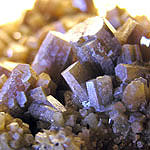
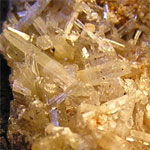
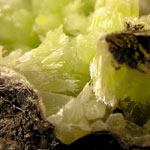
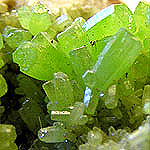
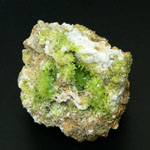
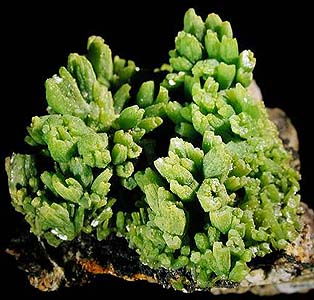

Pyromorfite. A brush of crystals to 1см is a fragment of the encrusted cavity in the breccia of hornfels (hornstone) rocks. Size of standard 7 sm Borough Yansho, 60 km south of city Guylin, Guansi пров., China. Pyromorfite. Broken-khill, N.Yu. Wales, Australia. A photo: © A.A. Evseev.
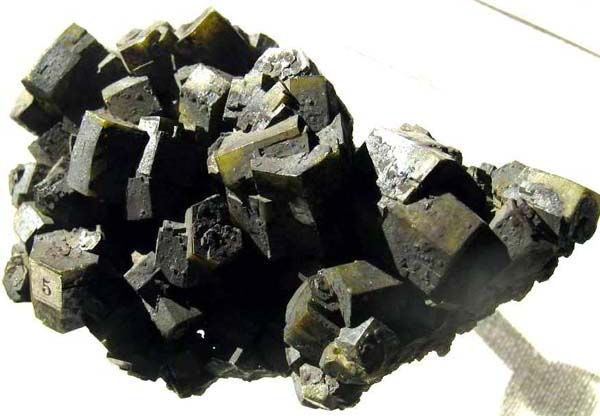
Pyromorfite. Fridrikhszegen, near Bad-ems, Germany. Crystals to 1-2 sm. A photo: © A.A. Evseev.
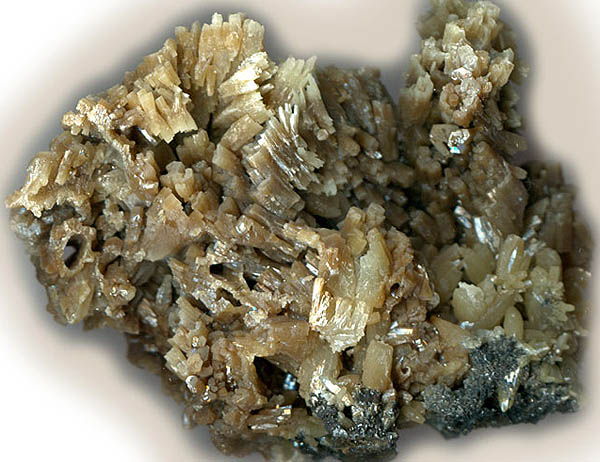
Pyromorfite. Madzharovo, Bulgaria. 6 sm. A photo: © В.А. Слетов.
Lead is a carcinogen and teratogen for the organism of people. It is vitally a necessity, as influences on the synthesis of albumen, power balance of cage and its genetic vehicle, participates in the exchange processes of bone tissues and gonads. In a norm in bones (cartilaginous and soft tissuess) maintenance of lead 20 mgs/kg, in a hepar is a 1 mg/kg, buds are 0,8 mgs/kg, cerebrum are 0,1 mgs/kg. For men (gonads) maintenance of lead in an organism is higher, than for women.
There are 2 mgs of lead in the organism of people. 5-10% is sucked in in a gastroenteric highway (and to 50%). A degree depends on solubility of his compounds. Plenty of lead can get in an organism with respirable air (a to 70% aerosol, containing lead, settles in lights). At the large concentrations of tetraethyllead there is a risk of his penetration through a skin. Lead hatches from an organism with an excrement (80-90%), and less part with urine.
The deficit of lead in an experiment reduces growth of animals, violates metabolism of iron, changes the action of some enzymes and concentration of separate metabolite in a hepar, related to status of iron. Lead is increased by growth and improves hematocrit, packed cell volume, PCV and concentration of haemoglobin at the deficit of iron for rats, this effect was the result of pharmacological action of lead. Mechanism by which lead influences on metabolism of iron - catalyst. Lead is needed: at lowered hematocrit, packed cell volume, PCV and haemoglobin, at the iron-deficient states.
For all of regions of Ukraine and Russia (CIS) lead is an anthropogenic toxic element from the group of heavy metals. It is related to high contamination and extrass of exhaust-gass of motor transport, working on the ethylated petrol. A from 5% to 30% population in cities suffer from surplus of lead. During sharp intoxication lead neurological symptoms, leaden encephalopathy, cerebropathy, "leaden" colic, nausea, locks, pains on all of body, decline of frequency of heart-throbs and increase of arteriotony, are marked. During chronic intoxication there is a hypererethism, hyperactivity (violation of concentration of attention), depression, decline of IQ (index of estimation of intellect), high blood pressure, peripheral neuropathy, neuritis, loss or decline of appetite, pains in a stomach, anaemia, nephropathy, "leaden border", dystrophy of muscles of racemes of hands et cetera
Displays of surplus of lead: hypererethism, weakness, fatigueability, decline of memory; head pains; defeats of the peripheral nervous system (pains are in extremities); appearance of leaden border on gum; decay of teeth, arthropathy, arthropathia, diseases of the bone system, increase of arteriotony, development of atherosclerosis, stomach-aches (leaden colics), spastic, spasmodic locks; exhaustion, weight loss, malnutrition, decline of mass of body, violations of porphyrinic exchange (urobilinogen, coproporphyrin), nephropathy, making progress kidney insufficiency worsening of mobility of spermatozoa and capacity for an impregnation, decline of potency, clasmocytoma, increase of amount of red corpuscles with a basophilous (basophilic) grittiness, anaemia, decline of stability to the infections (especially for children), development of syndrome of saturnism (lead poisoning), decline of maintenance in the organism of calcium, zinc, selenium.
- During the concentration of lead for children violations of development register in blood of 10-20 mkg/100 ml.
- During the proper concentration from 20 to 40 mkg/100 ml is observed decline of IQ.
- During the concentration of lead in blood at adults and children from 40 to 60 mkg/100 ml is marked anaemia and peripheral neuropathy, neuritis.
- During the concentration of lead in blood grown people from 60-80 mkg/100 ml has chronic nephropathy.
- During the proper concentration from 80-100 mkg/100 of ml sharp nephropathy is marked.
- During a concentration from 100-120 mkg/100 of ml is encephalopathy, cerebropathy.
The toxic action of lead is conditioned ability to form compounds with the large number of anions - ligands, which sulfhydryl groups, derivates of cystein, imidazole and carboxyl groups, phosphates, behave to. As a result of binding of ангидридов to lead the synthesis of albumens and activity of enzymes is repressed, for example Atf-azy. Lead is violated by the synthesis of гема and hematohistone, interfering in a porphyrinic exchange, induce the defects of membranes of red corpuscles. On a background the deficit of iron, calcium, phosphorus, magnesium and zinc ability of organism to master lead is increased. Sulfur-containing amino acid, vitamins of A, C, E, groups of B, folacin, Nicotinamidum, calcium, magnesium, zinc, iron, chrome, phosphorus, selenium instrumental in the decline of level of lead in an organism.
